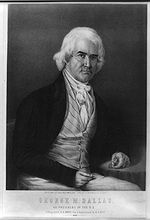Alfred Hoffy
[1][2][3] Born in London, he immigrated to New York City in 1830 after serving for years in the British Army and reaching the rank of major.
In 1830, Hoffy left the army and emigrated to the United States, landing in New York City, where he went into business with the British lithographer J.T.
His subjects ranged from news events—the arrival of an Egyptian sarcophagus in Philadelphia; the 1835 Great Fire of New York—to portraits drawn from daguerreotypes of such well-known people as General Santa Anna and financier Cyrus West Field.
[3] He produced numerous lithographic plates of Native American chiefs, based primarily on paintings by Charles Bird King, to Thomas McKenney and James Hall's History of the Indian Tribes of North America (1837-1842).
Hoffy's Orchardist's Companion: A Quarterly Journal, Devoted to the History, Character, Properties, Modes of Cultivation, and All Other Matters Appertaining to the Fruits of the United States was praised in the local and national press for its usefulness and especially for the "superb colored engravings of fruits".
[2] Despite the praise, Hoffy published only five issues over two years (1841–43) before ending production, as it was too expensive and he could not cover his costs by subscriptions.



